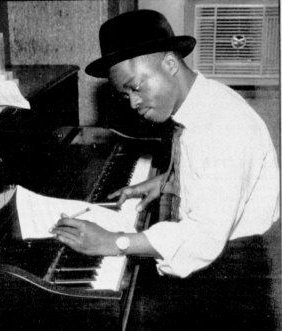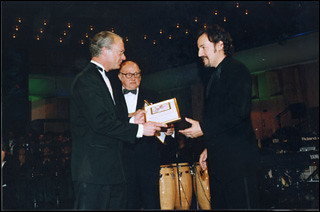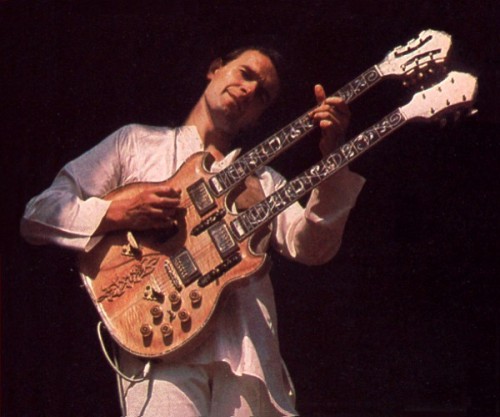1957: He had appeared on his parents' radio show and later on television. On this date, Ricky Nelson first appeared on the chart with his first single, "A Teenager's Romance".
1963: Andrew Oldham and agent Eric Easton signed a management contract with the Rolling Stones. (Note: some websites report that this occurred on April 29, 1963. This is incorrect, according to the book 'The Rolling Stones: A Musical Biography' by Murry R. Nelson. According to Nelson, the contract was signed on May 6.)
1965: Keith Richards began writing the Rolling Stones song "Satisfaction" in a hotel room in Clearwater, Florida.
1965: James Brown recorded "I Got You (I Feel Good)" at Criteria Studios in Miami, Florida.
1965: Marianne Faithful married John Dunbar in Cambridge, England.
1966: Bob Dylan played at the ABC Cinema in Belfast, Northern Ireland.
1967: Aretha Franklin led the way on the R&B chart for a seventh week with "I Never Loved A Man (The Way I Love You)".
1967: Frank & Nancy Sinatra remained at the top of the Easy Listening chart with "Somethin' Stupid".
Steve Winwood & the Spencer Davis Group...
1967: Frank Sinatra & daughter Nancy had the #1 song for the fourth week--"Somethin' Stupid". The Supremes moved from 8 to 2 with "The Happening" while "Sweet Soul Music" by Arthur Conley ranked third. The Monkees fell with "A Little Bit Me, A Little Bit You" and the former #1 "Happy Together" by the Turtles was now at #5. The rest of the Top 10: "I Think We're Alone Now" from Tommy James & the Shondells, the Buckinghams with "Don't You Care", Peaches & Herb jumped from 18-8 with "Close Your Eyes", the Dave Clark Five reached the Top 10 with "You Got What It Takes" and the Spencer Davis Group moved from 13-10 with "I'm A Man".
1967: The Monkees remained at #1 for the 13th week on the Album chart with More of the Monkees. Counting their debut release, the group spent their 26th consecutive week at #1.
"Mood for a Day" from Yes...
1972: Roberta Flack remained at the top of the Album chart with First Take. Neil Young advanced with Harvest, swapping spots with America and their self-titled debut. Eat a Peach from the Allman Brothers Band remained in its position while Yes stayed at 5 with Fragile. The rest of the Top 10: Paul Simon and his self-titled album, Smokin' from Humble Pie, Nilsson dropped with Nilsson Schmilsson, Stanley, Idaho's Carole King moved back up after 57 weeks of release with the classic Tapestry and Graham Nash & David Crosby entered the Top 10 with the appropriately named Graham Nash/David Crosby.
1972: The Staple Singers took over at #1 on the R&B chart with the great song "I'll Take You There".
1972: Roberta Flack had one of The Top Adult Songs of the 1970's*, as "The First Time Ever I Saw Your Face" was #1 for a sixth week.
1972: The Carpenters had one of the hottest new songs as "It's Going To Take Some Time", a song written for them by Stanley, Idaho's Carole King, moved from 79 to 43.
The Stylistics hit the Top 10 for a second time...
1972: Roberta Flack remained at #1 for a fourth week with "The First Time Ever I Saw Your Face". Joe Tex peaked at 2 with "I Gotcha'", the Stylistics were next with "Betcha' By Golly, Wow" and Michael Jackson checked in with "Rockin' Robin". The rest of the Top 10: Aretha Franklin's "Day Dreaming", America with their former #1 "A Horse With No Name", the Staple Singers rocketed up from 18 to 7 with "I'll Take You There", Jackson Browne with "Doctor My Eyes", Al Green edged up with "Look What You Done For Me" and Ringo Starr slid in with "Back Off Boogaloo".
1973: Paul Simon began his first tour without Art Garfunkel at the Boston Music Hall in Boston, Massachusetts.
1974: The Hues Corporation released the single "Rock The Boat".
1974: The Righteous Brothers released the single "Rock And Roll Heaven".

1978: At the peak of their career, and during one of the hottest times for any artist in the Rock Era, The Bee Gees announced that they would donate money from concerts to UNICEF.
1978: Johnny Mathis & Deniece Williams remained at #1 on the R&B chart for the fourth week with "Too Much, Too Little, Too Late".
1978: England Dan & John Ford Coley beat all challengers for a sixth week at #1 on the Adult chart with "We'll Never Have To Say Goodbye Again".
Billy Joel's title track from his breakthrough album...
1978: The Soundtrack to "Saturday Night Fever" was #1 for the 16th straight week on the Album chart, with London Town by Wings making a feeble attempt to challenge. Eric Clapton's Slowhand dropped while Kansas edged up with Point of Know Return. Jefferson Starship elevated with Earth. The rest of the Top 10: The Stranger from Billy Joel, George Benson fell with Weekend in L.A., Jackson Browne moved up to #8 with Running On Empty, Chuck Mangione entered the Top 10 with Feels So Good and Warren Zevon was the final entry with Excitable Boy.
1978: The Bee Gees dominated at #1 for an eighth straight week with "Night Fever". Counting their #1 hit, "Stayin' Alive", and "(Love Is) Thicker Than Water", a song they wrote for brother Andy Gibb, Bee Gees' compositions had been at #1 for 14 straight weeks.
1982: Diana Ross was awarded with a star on the Hollywood Walk of Fame at 6712 Hollywood Boulevard.
1989: Jody Watley had the new #1 on the R&B chart with "Real Love".
1989: Cher & Sun Valley, Idaho's Peter Cetera teamed up for a third week at #1 on the Adult Contemporary chart with "After All".
1989: Madonna remained at #1 for the third week on the Album chart with Like a Prayer. Paula Abdul re-entered the Top 10 after 42 weeks of release with Forever Your Girl.
1989: Richard Marx had a high debut (#39) with "Satisfied".
1989: "Like A Prayer" by Madonna was #1 for a third week. Bon Jovi remained second with "I'll Be There For You", Jody Watley was up to 3 with "Real Love", Tone Loc slipped with his "Funky Cold Medina" and Paula Abdul moved from 10 to 5 with her latest, "Forever Your Girl".
1983: Kai Winding, who gave us the instrumental "More", passed away from a brain tumor in New York City, just short of his 61st birthday.
1992: Michael Jackson paid the funeral expenses for Ramon Sanchez, a nine-year-old boy that had been killed in a drive-by shooting during the Los Angeles riots. (Note: some websites mistakenly say this happened on May 22. According to the United States Congress House of Representatives Bill 600, as well as the books 'Michael Jackson: The Icon' by Jos Borsboom and 'Michael Jackson: The Autopsy Is In...It Was Homicide' by Phyllis Jager, and 'Jet' magazine, the correct date is May 6.)
1993: The Internal Revenue Service seized assets of $1.6 million from Jerry Lee Lewis for unpaid taxes.
1995: Oasis had their first #1 in the U.K. with "Some Might Say".
1995: Boyz II Men had one of the hottest new songs as "Water Runs Dry" moved from 38 to 10.
"Selling the Drama" from Live's amazing release
1995: Live completed one of the most improbable rises to #1 in rock music history when their great album Throwing Copper reached #1 in its 52nd week on the album chart.
1996: Metallica began two days of recording for the music video "Until It Sleeps".
2001: Destiny's Child had the #1 album in the U.K. with Survivor.
2002: Ray Charles received an honorary degree of philosophy from Albany State University in his hometown of Albany, Georgia.

2002: Otis Blackwell died of a heart attack in Nashville, Tennessee at the age of 71. Blackwell was the writer of hits such as "Don't Be Cruel" for Elvis Presley, "Great Balls Of Fire" for Jerry Lee Lewis and "Handy Man" (originally by Jimmy Jones and later by Del Shannon and James Taylor).
2003: MTV featured Metallica as a "MTV Icon" in a 90-minute special.
2005: Audioslave became the first group to perform in Cuba when they played at La Tribuna in Havana.
2005: A bronze life-size statue of James Brown was unveiled on Broad Street in Augusta, Georgia.
2008: Cher played the first of 192 dates at the Las Vegas Colosseum in Nevada.
Born This Day:
1917: Kal Mann, who wrote "Butterfly" for Charlie Grace, "Teddy Bear" for Elvis Presley, "Wild One" for Bobby Rydell, "You Can't Sit Down" for the Dovells and "Let's Twist Again" for Chubby Checker among others, was born in Philadelphia, Pennsylvania; died November 28, 2001 from Alzheimer's disease in Pompano Beach, Florida. (Note: several websites, including the notorious 'Allmusic.com', erroneously report that Mann died in Philadelphia. According to credible sources such as 'Billboard', Mann died at his home in Pompano Beach, Florida.)
1924: Denny Wright, guitarist for Lonnie Donnegan, Ella Fitzgerald, and many others, was born in Deptford, London; died of bladder cancer February 8, 1992.
1942: Colin Earl of Mungo Jerry ("In The Summertime") was born in Richmond upon Thames, London. (Note: some websites report that Earl was born in Hampton Court, London. Hampton Court is a royal palace, not a city, located in the London Borough of Richmond upon Thames.)
1945: Bob Seger was born in Dearborn, Michigan.
1948: Mary MacGregor ("Torn Between Two Lovers") was born in St. Paul, Minnesota.
1950: Robbie McIntosh, drummer of the Average White Band, was born in Dundee, Scotland; died of drugs September 23, 1974 in Hollywood, California).
1960: Larry Steinbachek (real name Lawrence Cole) of Bronski Beat ("Smalltown Boy") was born in London.
1960: John Flansburgh of They Might Be Giants was born in Lincoln, Massachusetts.
1962: Adam Yellin, engineer, mixer, producer and record company executive, who worked with the Rolling Stones, Kiss, Billy Idol, Debbie Harry and the Ramones, was born in New York City.
1964: Tony Scalzo of Fastball was born in Honolulu, Hawai'i.
1967: Mark Bryan, founding member and lead guitarist for Hootie & the Blowfish, was born in Silver Spring, Maryland.
1971: Chris Shiflett, guitarist of the Foo Fighters, was born in Santa Barbara, California.

.jpg)

























.jpg)
